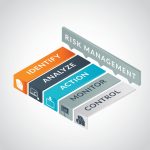Use knowledge, experience, skills to identify risks
Living day to day we know there is a chance of something
negative happening. This something negative is a risk. For example, we know there’s a chance that when we get behind the wheel of a car, we could get into a car accident.
And a lot of times, we also think about the chance of the risk, its probability and the impact before it occurs.
The probability and impact will differ for different scenarios, of course: a new driver has higher probability of an accident than a more experienced driver. A non-insured driver has bigger financial impact than an insured driver if she gets into a car accident.
When it comes to business, it’s pretty much the same. There is a chance of something negative happening. As we transition to entrepreneurship, it’s not uncommon to have and think about the fears associated with business risks.
These fears include the fear of consequences, the fear of not knowing how to handle certain business situations, and the fear of not having skills to handle certain business situations.
I have found the best way to address these fears, and risks, is to start listing the risks themselves. A good way to start is to group by internal vs. external risks.
Internal
Internal risks are the risks that are internal to your company. You have probably thought of these already in terms of fears. Low sales due to lack of skills. Low customer engagement due to lack of social media knowledge. Reduced income due to lack of financial knowledge.
External
External risks are the risks that are external to your company. Whereas we often fret over fears that are internal risks, we sometimes spend less thought on external factors that could also harm our business. Factors that are external and therefore can’t be controlled by us include pricing pressure and government regulation.
Me for example
I started a craft business a decade ago. My fears were mainly focused on internal risks.
- I was somewhat concerned with being able to produce enough to stock the shelves, so to speak.
- I was afraid my car wouldn’t hold all my inventory plus the tent for craft fairs.
- I was afraid I wasn’t organized enough.
But I did not consider external risks enough prior to starting my craft business.
- I did not think about the saturation of jewelry makers in the market.
- Nor did I think about how the ease of entry to becoming a jewelry maker was a risk to my start up craft business.
I learned the hard way so I will always plan around internal AND external risks for future endeavors.
Risk is not an issue
As we list risks, it’s important not to include issues. I sometimes hear folks use the terms issue and risk interchangeably. I urged you not to do that.
Issues have materialized whereas risks have not. Having your subconscious identify a risk as a current issue when it’s not, can cause unneeded stress and additional fears. And as we transition from employee to entrepreneurship, we have more than enough fears to deal with.
Of course to be successful we do need to address certain risks (I will show you how) but worrying about risks as if they have occurred already will create a chaotic environment.
By looking at risks methodically, we stay focused and calm.
This may be a new adventure but you really do know a lot. Your experience, knowledge and skillset gained from working for another business is of great value.
So what are some of the risks you have identified already for your business, future or current? Please share in the comment section.

Leave a Reply